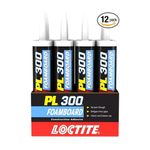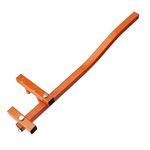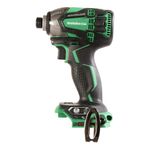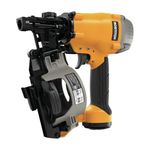my home has 20 amp lines on the main panel. I have been doing some wortk on the house and i find that most of the receptacles are 15 amp throughout the house
i do a fair amount of electrical work and have never seen this, has anyone else and is this code? doesnt seem right to me and is it particularly dangerous
Fine Homebuilding Recommended Products
Loctite Foamboard Adhesive
When foam board installations require an adhesive, it’s important to use compatible products like this adhesive from Loctite.
Cepco BoWrench Decking Tool
This tool makes straightening deck boards a breeze during installation.
Metabo HPT Impact Driver (WH18DBDL2)
This impact driver is a small, light, and powerful tool featuring three hammers and anvils instead of the usual two.
Roofing Gun
This lightweight, pneumatic roofing nailer is capable of driving ¾-in to 1¾-in coil roofing nails and has a depth adjustment wheel to dial in nailing depth on the various shingle types you're likely to encounter.
Ladder Stand Off
Stability is key when working off a ladder or accessing the roof, and this lightweight aluminum stand-off makes any extension ladder safer and more comfortable to use.




















Replies
That is one of those fuzzy areas. Actually, what you have is considered normal. One 20 amp breaker can provide power to multiple 15 amp outlets.
Now, each of those outlets can only plug in something that will draw less than 15 amps, though theoreticly you could plug two 15 amp devices into one outlet.
There are 20 amp outlets, they have the horizontal slot along with the regular vertical slots.
well i just thought this was odd. When i do wiring i use 20 amp receptacles on 20 amp circuits and 15 amp receptacles on 15 amp circuits, i never use 15 amp receptacles on 20 amp 12/2 lines.
20 amp lines?
Do you mean you have only #12 wire on 20 amp breakers?
Have you pulled recepticals to see what they are rated for or just looking at the blade pattern. Some of the old 20 amp recepticals have the same patern as the current 15 amp devices.
Even if they are 15 amp there is liitle danger in having them on a 20 amp circuite. All 15 amp devices are now rated for 20 amp pass through current and it is very unlikely that yopu will ever load a circuite enough to cause a device to fail, Most receptical melt downs and fires come from loose connections, not the device failing.
wire size
yes i pulled the receptacle and looked at the wire and its 12/2
On these 20 amp circuits i have 15 am rated receptacles. As far as I know the 15 amp receptacles are in place in places you would expect to see 15 amp circuits like bedrooms etc.
The NEC specifically allows you to have multiple 15-amp receptacles on a 20-amp 'convenience' circuit.
All UL-listed 15-amp receptacles are tested to the exact same standards as the 20-amp receptacles, expressly for this reason.
What you have is both normal and safe.
thanks
good to know
All standard "15A"
All standard "15A" receptacles are rated 20A pass-through and are legal to be installed on a standard 20A multiple-receptacle circuit.
In fact, I suspect that all 15A receptacles have passed UL tests to safely handle 20A -- the design's the same inside, and the surface area on the neutral prong is the same, so there's no reason they would be different.
The intent is to prevent you from plugging multiple 20A devices into a single 20A circuit.
What you're describing is perfectly legal, code-wise, and is done all the time.
so i have another question then
i have done alot of electrical work myself including installing main panels and sub panels and outside work. every time i have run a 20 amp 12 line i use 20 amp receptacles, am i wrong to do so ?????
I think there may be some rule that limits having MULTIPLE 20A receptacles on a 20A circuit. But it's in one of those impenetrable code sections that's written in code.
It may seem obvious, but before you can get the right answer, you have to ask the right question. In this case, we start with "what are you trying to do?"
Appliances with 20-amp plug are generally intended to have their own circuit. The only reason they have the different plug is because they need the extra power - which leaves little left on the circuit for anything else.
Yet, a 20-amp receptacle is designed to also accept 15-amp plugs ... and those are the plugs we have for everything else- no matter how little power is needed.
We have here a head-on collision between two of the basic assumptions of the electric code. Assumption #1 is that we will size the circuit to the load; assumption #2 is that we want to have receptacles every so often for our 'convenience.'
My advice: Don't re-invent the wheel, or try to play engineer. You want 'better' receptacles, buy better quality 15-amp receptacles for your 20-amp convenience circuits. If you have something that needs a 20-amp receptacle, give it it's own circuit.
Counter-Intuitive Even
Amish Electrician has explained it perfectly.